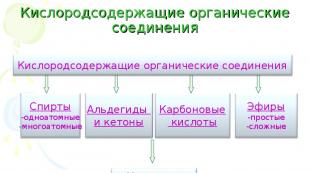Industrial exodus. Enterprises are in no hurry to move to the outskirts. Industrial cities Industrial cities of Russia
Chairman of the Committee on Economic Development, Industrial Policy and Trade Alexey Ivanovich SERGEEV tells more about the progress of this process, as well as how the city sees the development of new industrial zones, in an interview with the magazine.
– At what rate is industry moving outside the center today? Which businesses have decided to move?
– The process of transferring industrial enterprises outside the historical center of the city has been going on for many years. At the same time, the functional purpose of territories previously occupied by industry is changing. Among the largest projects are the relocation of the Petmol OJSC plant and the construction of a new workshop for the production of children's dairy products in the Parnas non-residential area. This is also the relocation of JSC Krasnoe Znamya to the Vostochnaya industrial zone and JSC NPP Burevestnik to Rybatskoye. Among the pioneers were also the Vulcan Plant and the First Furniture Factory. The relocation of the terminal and logistics complex of Module LLC from the territory of the Varshavsky railway station is in its final stage.
In the near future, Sestroretsk Tool Plant OJSC is expected to move from Sestroretsk to the Konnaya Lakhta zone. Space Motor CJSC is moving production to Konnaya Lakhta from the Northern Valley region. Also, JSC Lenpoligrafmash is ready to move from the embankment of the Karpovka River to the non-residential zone "North-West".
The relevant committees of St. Petersburg supported the idea of changing the functional purpose of a number of territories, giving them the status of residential development zones.
In particular, these are the production sites of the branch of OJSC Power Machines - the Elektrosila plant, OJSC Optimed-invest and OJSC KLIMOV.
The territories occupied by Kompressor OJSC, FSUE Plant named after. Kalinin", CJSC "Izmeron Plant", OJSC "Steel Rolling Plant", OJSC "Nevskaya Manufactory". Such changes are a green light for investors who want to buy the rights to the territory from enterprises for the purpose of redevelopment.
According to recent amendments to the General Plan of St. Petersburg, the area of industrial territories now amounts to 18 thousand hectares - 13% of the area of the entire city.
– Which of the existing industrial zones are being developed most actively?
– Konnaya Lakhta, Metallostroy, Rybatskoye, Izhora Plants, Novo-Orlovskaya, where the next residents of the SEZ will be located.
Among the promising territories, we should highlight Predportovaya-3, which will be allocated for IT cluster enterprises, and Beloostrov.
– How is land management and engineering preparation of new industrial zones carried out?
– In 2007–2010 About 1.1 billion rubles are allocated to KERPPiT as a state customer for the construction of engineering infrastructure facilities. In 2007, 200 million rubles were spent for these purposes.
In 2008, 350 million rubles are allocated. In 2009 – 350 million rubles. In 2010 – 200 million rubles.
Last year, planning projects and land surveying projects for the Krasnoselskaya and Shushary-2 zones, as well as the Neudorf and Novo-Orlovskaya SEZs, were approved. There are projects for planning and land surveying for the industrial zones “Rybatskoye”, “Ruchi”, “Obukhovo”, “Rzhevka”, “Predportovaya-3”, partially for the territories “Yugo-Zapadnaya”, “Beloostrov”, “Pushkinskaya”, “ Kolomyagi", "Parnas", IT park sites.
In the next two to three years, it is planned to carry out engineering preparation of the industrial zones “Metallostroy”, “Predportovaya-3”, “Konnaya Lakhta”, “Parnas”. This process will continue in Kamenka, Shushary-2, and Rybatsky. The design of integrated sanitary protection zones for industrial areas has begun.
– Is it possible to motivate owners and managers of enterprises to more actively move their capacities outside the center? What effect do the applied economic levers have?
– There is no dictate from the city executive power. Based on economic benefits, business itself decides how expedient it is to transfer production facilities from the city center to industrial zones.
Today, land rental rates in the city center are much higher than in industrial zones, so maintaining an industrial site in the city center is becoming ineffective. Industrialists are beginning to count lost profits. In most such cases, a residential building or business center shows greater profitability. In addition, old enterprises need to update their machine tools and technologies. Technical re-equipment makes it possible to produce the same volume and range of products in a smaller area.
The laws of St. Petersburg “On tax benefits” and “On state support for investment activities in the territory of St. Petersburg” also provide for certain tax benefits.
For investors who, within one calendar year, have made investments in fixed assets that were not previously in operation in St. Petersburg for an amount exceeding 150 million rubles, the corporate property tax rate is halved for a period of 3 years.
If investments amount to 150–300 million rubles, the income tax rate is reduced from 24% to 22% for the same period. If it is over 300 million rubles, the rate is reduced to 20% in the part that falls into the regional budget.
If the amount of investment in fixed assets during 3 calendar years of investment is at least 3 billion rubles, then the city provides the investor with benefits for a period of 5 years. In particular, the enterprise is exempt from property tax, and the profit tax rate is also reduced to 20%.
The city also helps to find a site convenient for future production in the designated areas. All applications for the provision of land plots for industrial enterprises are submitted to the St. Petersburg Investment Department.
The department submits the application to the City Agency for Industrial Investment. The agency actually provides individual project support. The size of capital investments, the scale of the project, its socio-economic significance for the city are the criteria by which a particular project is recognized as important or strategic.
– Does the integrated development of territories for industrial construction make urban planning and economic sense?
– The city’s approach to the system of development of industrial territories is fixed in the Industry (cluster) scheme for the development and specialization of industrial zones of St. Petersburg. The document was developed by KERPPiT and KGA.
The main reason for the emergence of the cluster scheme was the shortage of large free plots (more than 10 hectares) for the location of industrial facilities. Also, the need for such a document arose due to logistical and environmental restrictions, as well as different volumes of land reserves within industrial zones.
In the process of forming industry specialization, the main and reserve functions of each industrial zone will be determined. Locations for engineering infrastructure facilities will also be pre-designated.
Prepared by Natalya Andropova
Increasingly, in the strategic development plans of our country, the government places emphasis on the need to move away from the status of a “raw materials power.” At the same time, the main emphasis is on developing its own processing of raw materials and establishing production, and large industrial centers are attracting increasingly close attention.
We offer Top 10 largest industrial centers in Russia, compiled according to data from the Institute of Territorial Planning "Urbanica".
10. Novokuznetsk
The volume of industrial production is 264 billion rubles.
The city has ferrous and non-ferrous metallurgy and coal industry enterprises. Among the owners of leading industrial facilities are Evraz Group, UMMC, Sibuglemet, Rusal.
9. Chelyabinsk
277.3 billion rubles.
The city is a recognized leader in Russia in the field of ferrous metallurgy, mechanical engineering and the food industry at a high level. In Chelyabinsk there are enterprises of Mechel OJSC, the Chelyabinsk Pipe Rolling Plant, Cheboksary Electromechanical Plant, Coca-Cola, and the Russian Technologies State Corporation groups.
8. Norilsk
312 billion rubles.
The life of this polar city is built around the activities of the leader in the field of non-ferrous metallurgy, MMC Norilsk Nickel.
7. Ufa
313.6 billion rubles.
The city received the status of a major industrial center thanks to the development of oil and gas processing, mechanical engineering, food and pharmaceutical industries. The owners of the leading enterprises are JSOC Bashneft, State Corporation Russian Technologies, Wimm-Bill-Dann, Pharmstandard.
6. Perm
331.3 billion rubles.
The city can boast of significant successes in the field of oil and gas refining, mechanical engineering, food and chemical industries. The owners of leading industrial facilities are OJSC Lukoil, State Corporation Russian Technologies and Roscosmos, Nestle, Henkel and others.
5. Omsk
RUB 348.4 billion
The city has large enterprises operating in such industries as oil and gas refining, chemical and food industries, and mechanical engineering. The main industrial facilities are owned by OJSC Gazprom Neft, Unilever, Wimm-Bill-Dann, State Corporation Russian Technologies and Roscosmos.
4. Nizhnevartovsk
481.6 billion rubles.
This is one of the leading Russian centers for oil and gas production and processing. The city has industrial facilities of TNK-BP, Gazprom Neft, Russneft, Slavneft, and SIBUR.
3. Surgut
800.3 billion rubles.
A leader in oil and gas production and refining, the city also has large enterprises operating in the electric power, food processing and R&D sectors. The main industrial facilities are owned by Surgutneftegaz OJSC, OGK-2, OGK-4, SIBUR.
2. St. Petersburg
1282.7 billion rubles.
The northern capital has industrial facilities in the food and chemical industries, mechanical engineering, ferrous metallurgy, construction materials production, and R&D. The city has production facilities of Philip Morris International Inc., JTI, BAT, Kraft Foods, Procter&Gamble, United Shipbuilding Corporation, Russian Technologies, Toyota, Nissan, GM, HP, Rosatom State Corporation, Intel and many others.
1. Moscow
1895.2 billion rubles.
 The capital's largest enterprises operate in such industries as mechanical engineering, food and pharmaceutical industries, oil and gas refining, and R&D. The main industrial facilities are owned by Roscosmos, Rosatom, Russian Technologies, Sukhoi Design Bureau, Renault, United Technologies, Volvo, Wimm-Bill-Dann, United Confectioners, Kraft Foods, Coca-Cola, RusHydro, GlaxoSmithKline.
The capital's largest enterprises operate in such industries as mechanical engineering, food and pharmaceutical industries, oil and gas refining, and R&D. The main industrial facilities are owned by Roscosmos, Rosatom, Russian Technologies, Sukhoi Design Bureau, Renault, United Technologies, Volvo, Wimm-Bill-Dann, United Confectioners, Kraft Foods, Coca-Cola, RusHydro, GlaxoSmithKline.
During the Soviet period industrial cities arose, as a rule, on the basis of a systematically developing industry. Thus, at one time Magnitogorsk, Novokuznetsk, Norilsk, Lipetsk developed rapidly on the basis of metallurgy, Kharkov, Chelyabinsk, Minsk on the basis of tractor manufacturing, Berezniki, Solikamsk on the basis of chemistry. Many new cities emerged, including those based on the development of the chemical industry (Nizhnekamsk, Navoi, Tobolsk), automotive industry (Tolyatti, Zhodino, Naberezhnye Chelny), metallurgy (Novolipetsk, Kostomuksha, Stary Oskol), oil industry (Tyumen, Surgut, Nizhnevartovsk) , hydropower, aluminum, forestry and woodworking industries (Bratsk, Ust-Ilimsk). On the basis of nuclear energy, new cities arose near Kostroma, Smolensk, on the Southern Bug, etc. The main city-forming objects were large enterprises of ferrous and non-ferrous metallurgy, chemistry, energy, mechanical engineering, timber industry complexes, etc.
Industrial cities often arise based on:
- one enterprise or production;
- an industrial complex of enterprises in one leading industry, where the leading enterprise is supplemented by related ones;
- several production complexes of various industries that are not directly related to each other.
When designing a city, the possibility of its development is always taken into account, since the emerging city itself serves as a place of attraction for other industries. It has become commonplace that in a city with an enterprise where male labor predominates (metallurgy, chemistry), production of light and food industries, instrument making, etc. is located, in which women predominantly work.
Also, during the Soviet period, cities emerged - scientific centers with research institutes, higher educational institutions and experimental production facilities. Among such cities, the Novosibirsk Academic Town, the Moscow region cities of Pushchino, Krasnaya Pakhra, Dubna, Chernogolovka, etc., became famous.
In industrial cities, up to 80% of workers are employed in city-forming industries.
In many cities, along with enterprises of class I and II in terms of sanitary characteristics, there is also a relatively harmless industry that requires a large number of qualified personnel. These include machine-building and instrument-making factories, watch factories and enterprises of machine tool, textile and light industries, etc.
With the emergence of the city-forming industry and the growth of the city itself on this basis, an accompanying or, as is commonly called, service industry is created. It includes enterprises of the light, food and meat and dairy industries, refrigerators, food and manufactured goods warehouses, trade establishments, public utilities and consumer services, urban transport, etc. Such enterprises are closely connected with the residential part of the city. Examples of the location of industrial enterprises are shown in rice. 2.
Fig 2. Examples of the location of industrial enterprises in the city: a - the industrial zone is located along the railway line passing through the city center, b - enterprises are located along the railway line passing along the outskirts of the city, and occupy a central position in it: c - enterprises are located along the river and railway lines; d - enterprises are concentrated in two large industrial zones of the city; d - enterprises are dispersed throughout the city; e - enterprises are concentrated in three large zones along railway lines; g - enterprises are located in the central part of the city and form several industrial hubs; and - enterprises are concentrated in one industrial area on the outskirts of the city along the railway line
When locating enterprises, their urban differentiation is necessary. Only on this basis can a harmonious integration of industry into the city organism be achieved. According to this principle, the General Plan of Moscow was implemented in the Soviet Union, which, in particular, laid down the principle of creating eight planning zones of the city. According to this plan, residential areas and places of employment of the capital's population are distributed evenly, which helps to bring housing closer to places of employment.
However, in modern urban planning there are many complex and difficult to solve functional, technical, social, economic, transport, architectural, aesthetic and other problems. Almost all of them are closely related to the development of industry.
A characteristic feature of modern urban planning, developing in the conditions of scientific and technological progress, is the intensity of the implementation of planned plans. For example, in a number of newly created cities, the initial population was planned to be 80-100 thousand inhabitants. However, many of these cities, already in the process of building the first industrial enterprises, grew based on the expansion of the industrial base of related or new industries faster than was determined by planned indicators.
Moscow, December 6 - “News. Economy". The OneTwoTrip for Business service conducted its own research, based on which a rating of the most popular destinations for business trips in Russia was compiled. Below we present the 10 largest business centers in Russia. 1. Moscow
Most often, employees of Russian companies go on short business trips: in 46% of cases, they were booked at a hotel for one night, another 23% of orders were for bookings lasting 2-3 nights, 31% for 4-7 nights, the study notes. 2. St. Petersburg
St. Petersburg naturally took one of the leading places in the ranking of the most popular cities for business tourism. Business tourists are significantly more economical than ordinary tourists: 51% of business travelers stayed in 3-star hotels, and in 42% of orders, the cost of their accommodation per night did not exceed 3,000 rubles, the study indicates. 3. Ekaterinburg
Seven out of ten participants in the rating are million-plus cities with developed economies, a large number of offices of large Russian and international companies, cities that have economic ties both with Moscow and with other regional centers, the authors of the study note. 4. Novosibirsk
Novosibirsk is the third most populous city in Russia. The administrative center of the Siberian Federal District, the Novosibirsk Region and its constituent Novosibirsk District; the city is the center of the Novosibirsk agglomeration. The largest trade, business, cultural, industrial, transport and scientific center of Siberia. 5. Nizhny Novgorod
Nizhny Novgorod is an important economic, industrial, scientific, educational and cultural center of Russia, the largest transport hub and administrative center of the Volga Federal District. Nizhny Novgorod is one of the centers of Russian information technologies. Companies in this area include Intel, SAP Competence and Development Center, Mail.ru, Yandex, Huawei, NetCracker, Orange Business Services, MERA Networks, MFI Soft (ALOE Systems), Symphony Teleca and other smaller companies (Auriga, Exigen Services, Tecom, Devetel, Capvidia, Five9, Datanaut, NKT, SoftDrom, etc.). 6. Khabarovsk
The second part of the participants - Khabarovsk, Krasnodar, Kaliningrad - are territories whose development has recently received increased attention, which also stimulates the demand for business trips to these cities, the authors note. Khabarovsk is a city in Russia, the administrative center of the Far Eastern Federal District of Russia and the Khabarovsk Territory. One of the largest political, educational and cultural centers of the Russian Far East. 7. Samara
A large economic, transport, scientific, educational and cultural center. Main industries: mechanical engineering, oil refining and food industry. Samara is a major center of mechanical engineering and metalworking, food, as well as space and aviation industries. There are more than 150 large and medium-sized industrial enterprises in the city. 8. Kaliningrad
Kaliningrad is the second most populous city (the first is St. Petersburg) in the Northwestern Federal District, the third (after Riga and Vilnius) in the Baltic states and the seventh among the cities on the Baltic Sea coast. Kaliningrad is one of the six main centers of internal migration attraction in Russia over the past two decades. The city is the core of the fast-growing Kaliningrad agglomeration with a population of over 715 thousand people. 9. Krasnodar
Krasnodar is a major economic and cultural center of the North Caucasus and the Southern Federal District, the center of the historical and geographical region of Kuban. Krasnodar is one of the largest economic centers in Russia. The city's industrial complex has more than 130 large and medium-sized enterprises, employing about 120.5 thousand people, or almost 30% of all those employed in the city's economy. The main directions are instrument making and metalworking, production of building materials, clothing and knitwear, furniture, tobacco products, food and agricultural products. High economic potential and a favorable investment climate attract the attention of representatives of domestic and foreign business. Effective business relations are maintained with enterprises in the USA, Turkey, Ukraine, Germany, Belarus, Greece, Italy, France, Israel, Austria, and Cyprus. 10. Kazan
Kazan is one of the largest religious, economic, political, scientific, educational, cultural and sports centers in Russia. The Kazan Kremlin is one of the UNESCO World Heritage Sites. Kazan is one of the largest industrial, financial, trade and tourist centers in Russia, a leading city in the Volga region in terms of investment in fixed capital and construction. The industrial basis of the city consists of mechanical engineering, chemical and petrochemical industries, light and food industries. Among the largest enterprises in Kazan are the large-scale chemical complex Kazanorgsintez, the oldest in Russia Kazan Powder Plant and a unique cluster of three aviation industry enterprises in Russia - the KAPO aircraft manufacturing plant (manufacturer of the world's largest strategic bomber Tu-160), the KVZ helicopter manufacturing plant and the KMPO engine manufacturing plant.
Industrial centre a city distinguished as the center of one or more industries. Often P. c. At the same time they also perform transport functions. The profile of extractive industry centers is usually narrower than that of manufacturing centers, since the production specialization of the former is determined by the use of a limited range of natural resources. In the USSR and other socialist countries P. c. are formed in the course of territorial planning for the development of productive forces.
Great Soviet Encyclopedia. - M.: Soviet Encyclopedia. 1969-1978 .
See what “Industrial center” is in other dictionaries:
industrial centre- A settlement in which industry serves as the main city-forming base and the main branch of specialization. Syn.: industrial hub… Dictionary of Geography
- (Latin centrum, from Greek kentron). 1) center, middle of a circle, ball, etc. 2) a political party in Germany, as a protest against the further development of the German Union in the name of the independence of the church from state power. Dictionary… … Dictionary of foreign words of the Russian language
industrial hub- A settlement in which industry serves as the main city-forming base and the main branch of specialization. Syn.: industrial center… Dictionary of Geography
growth center- An industrial center or an entire area designed to give impetus to territorial development in the surrounding region, spreading its influence from the center to the periphery. Syn.: growth pole… Dictionary of Geography
Adj., used. compare often 1. Industrial raw materials refer to natural materials used in the production of means of production and consumer goods. Strategic reserves of industrial raw materials are the key to the future for the country’s economy. 2.… … Dmitriev's Explanatory Dictionary
A, m. 1. math., physics. The point of intersection of which l. axes, lines in a figure, the point of concentration of which l. relationships in the body. Center of pressure. Center of the lens. Center of the circle. Center of similarity. Center of symmetry. Center of the ellipse. 2. A place equally distant from... ... Small academic dictionary
center- a, m. 1) (what, only units) Middle, middle part of what l. City center. Be in the center of the site. It [the veranda] is already empty. In the corner, some company was finishing their drink, and in the center of it, a familiar entertainer in a skullcap and with a glass of Abrau in... ... was bustling around. Popular dictionary of the Russian language
A territory with a pronounced industrial production specialization. Etc. in the USSR and other socialist countries, it systematically specializes in those industries that produce products with the least cost... ... Great Soviet Encyclopedia
Industrial area ... Wikipedia
Promyshlenny passage Moscow General informationMoscowRussia Country Russia City Moscow District ... Wikipedia
Books
- Kharkiv. Guide for tourists and excursionists. X A PbKOBCKOE COUNTY OF NATURE LOVERS Introduction General information about Kharkov Kharkov is a large commercial and industrial center Kharkov architecture. Medical assistance in Kharkov. Arrival in…









